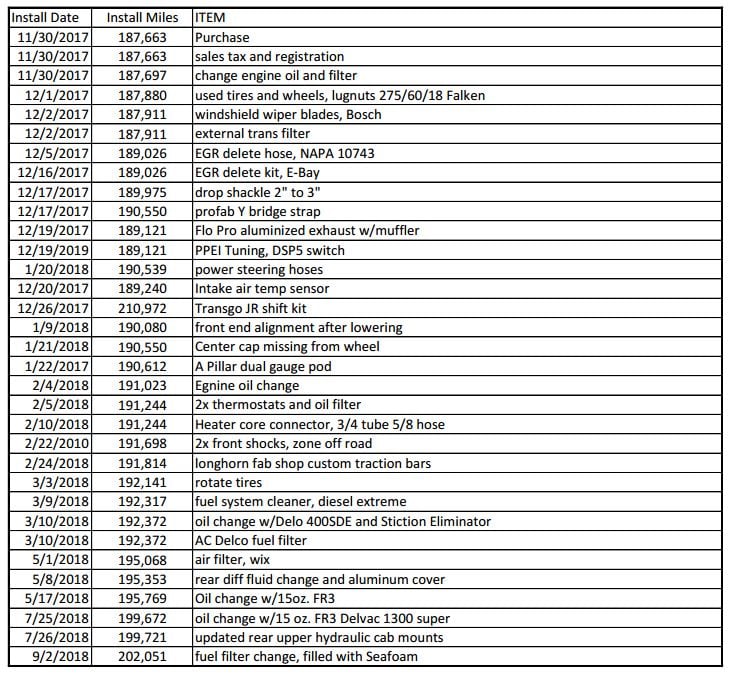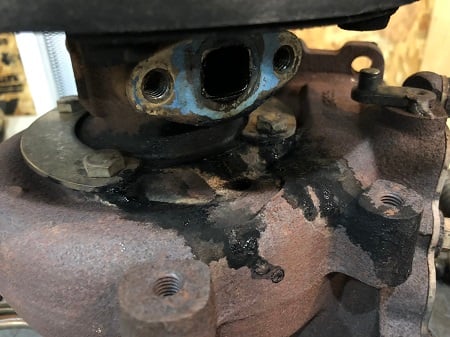Written By: Lawrence “LT” Tolman
The big three started selling diesel pickups pretty heavily in the early 90’s, and as time went on, they have only continued to grow in popularity and sales numbers. If you want to get your hands on an oil-burner of your own, it’s just a few clicks away. You could buy an old worn-out work truck for a couple thousand bucks, or you can roll downtown to your favorite dealership, sign on the dotted line, and ride home in style in a brand-new diesel luxury liner. But what is the best choice? Is there any advantage to buying second-hand, or is brand new the only way to go? Let’s dive right in, and maybe we can shed some light on this age-old question.
The Old Beater
If you are just starting out in life or need a set of wheels but have a shoestring budget, you’ll be looking at the more cost-effective end of the spectrum. There are many diesels which can be had for $5,000 or less, but there are only two worth your time. The first would be a 12-valve Cummins powered 2nd gen Ram (1994-1998), and the second would be an OBS 7.3-liter Powerstroke (1994-1997). For a $5,000 budget, you can’t be too picky, as you can almost bet the cosmetics will need some help, and the luxuries will be sparse at best, but the mechanical bits should have plenty of life left, even if the odometer starts with a three.
From a cost standpoint, owing a 25-year-old diesel does have its benefits. Likely you’ll have no monthly payment on the truck, the insurance will be next to nothing, and the annual taxes/registration will be minimal. You will be saving some money compared to owning a new truck, but you should expect to spend a few dollars each month, as there will inevitably be some repairs needed sooner or later. If you are handy with a wrench and don’t mind tackling the occasional mechanical project, then an older model truck may be just the ticket, since you can handle whatever comes up, and the cost of parts won’t be that much. However, if you have to take your vehicle to a repair shop for basic maintenance, then you might not want to start with an older diesel. While generally the trucks are very reliable, there will be a lot of smaller items that need to be addressed, whether it’s an oil leak, worn suspension bushing or ball-joint, wiring issue, shabby interior or body damage, or simply a replacement set of tires. If you’re paying an hourly rate, (which today averages between $60-$100 an hour at an independent shop) the costs will escalate very quickly. There’s no shame in having a shop work on your rig, but if you don’t turn wrenches yourself, then it might be wiser to invest in a slightly newer truck.
From a modification or “project truck” standpoint, an old cheap diesel is a great way to get started. There are no warranties to void, parts are plentiful and affordable, and with a few smart purchases, you can have a powerful weekend toy with less invested than the cost of a new side-by-side. Plus, there’s no better feeling that beating a fancy sports car with a junky old beater truck with mis-matched body panels.
Brand New Truck
There are few things more exciting than rolling down to your dealership of choice and picking out your very own brand-new pickup. The modern truck buyer is very discerning, and as such, there are more options available today than ever. If you want an all leather interior, multi-media integration, heated and cooled seats, full-length sunroof, LED lighting and more, its as simple as checking a box on the order sheet. However, be careful to not get too carried away when you’re picking out options, as the basic diesel pickup will start in the ballpark of $45k and can go up to almost $100,000 when fully equipped. But the pain doesn’t stop there. If you finance the average cost of a $65,000 truck for five years at six percent interest, your monthly note will be just over $1,200. Right off the bat, sales tax will run you around $6,000 depending on where you live, your insurance will be at least a couple hundred bucks every month on top of that, and then you still have to put fuel in the tank and groceries on the table. Plus, you can’t forget the intangible cost of depreciation which starts the minute you drive off the lot.
You do get a few benefits from dropping that much coin, however. You will be rocking a truck which is not going to have any maintenance costs, and any repairs which do pop up will be covered under warranty. But speaking of that warranty, if you want to make any modifications to the truck (and can afford any after paying for the truck each month) just remember almost any aftermarket part you install could void the warranty of your shiny new truck.
Slightly Used
Somewhere between the old beater and a brand-spanking-new truck lies the sweet spot where most pickup owners will land. If you can afford between $15 and $30 thousand bucks, you can have a very nice truck around 5 to 10 years old which still has a ton of life left in it. In that price range, you should expect to find a rig with at least 100,000 miles, which is not a big deal at all, since there is easily another 200k to go. Your monthly payment (if financed) will be between $300 and $600, your insurance will be very affordable, the initial hit of depreciation will have been taken by the previous owner, and likely any factory warranty will be expired. But for all these reasons, the goldilocks truck has my vote for buying a diesel truck.
You have to be careful when shopping for trucks within this price range, as there are a few which you may want to avoid, particularly the Ford 6.0-liter Powerstroke. It cost thousands of dollars to make them reliable, and while they can be bulletproofed, and it’s very hard to determine if the job has already been done simply by looking under the hood, so unless the truck comes with a stack of receipts or some other way to prove the work has been done, it just might not be worth the risk. But if you love the style and interior options of a Ford, you may look for a 6.7 Powerstroke, as they’re much more reliable, and used examples can be found in the high teens to low 20-thousand-dollar range. The best option for the GM crowd for reliability and price would be an LBZ or LMM, and the Ram guys will lean toward a 6.7 Cummins from 2008 and newer.
Buying Stock or Modified

If you’re reading this article, likely you’re planning on modifying your truck at some point in the future, but you’ll also notice there will be many trucks on the market which already have some modifications, which might seem appealing at first. But is it worth going down the rabbit hole of someone else’s project truck? The answer is simple… it depends. How a person cares for their truck can tell you a lot about its condition. If you show up and the truck is clean outside, inside, and under the hood, that’s a good first sign. If the previous owner can provide a detailed maintenance history showing things like what repairs have been done, mileage, cost, and other details, then chances are any common problems have likely already been addressed. Chances are also pretty good if the same truck has been modified, any upgrades will be properly installed with no issues. However, it’s always a good idea to have a trusted mechanic give any used truck a thorough once over, especially if it’s been modified.

A rule of thumb, if it seems too good to be true, then chances are it is. Here’s a real-world example that rolled into my shop last month. I have a friend that flew to Texas to purchase a 4th gen Mega Cab Ram with only 50,000 miles on it. According to the listing, it had some very popular upgrades as well; a second-gen turbo swap, head studs, a “built” 68RFE trans, some audio upgrades, nice wheels and tires, and based on the description and asking price, it sounded like the deal of the century. When he arrived to look at the truck, it was covered in mud, the interior was neglected and filthy, there was minor body damage on the rear door, and overall it was clear the truck was not well cared for. To make a long story short, none of the “upgrades” had been installed properly, it had a blown head gasket, a leaky turbo and warped exhaust manifold, and it’s going to take many hours of labor to correct the issues caused by the amateur mechanic who owned the truck previously. However, the condition of the truck did allow the purchaser to negotiate a very fair price, and even after the repairs are done, he’ll still be money ahead. But if a potential buyer wasn’t keen enough to spot these issues before pulling the trigger on the deal, he or she would’ve been in for a nasty surprise. Caveat Emptor.
Goldilocks and the Three Trucks
As a diesel enthusiast, what type of truck you buy depends on your tastes, your budget, and your brand loyalties. As much as we’d all love to roll around in a pimped-out brand-new pickup, that’s not always an option. And as cool as you might feel daily-driving a mid-90’s pickup, you better face the reality of dirty hands, an oil-spotted driveway, and the occasional visit to the shop. What makes the most financial sense is finding a well-cared for second-hand diesel in bone stock condition, and slowly transforming it into the truck of your dreams. But at the end of the day, what makes the most sense isn’t what we always choose as a truck enthusiast, but as long as you know the ramifications and have a game plan, then I say any diesel is better than no diesel.


I like the 5.9 3rd gens Rams 2007.5 and older a little better than the 2008 6.7s. No DEF fluid or EGR valve to clog up your engine. If you want the most reliable of those 2004-2005 has the better wiring/can bus system.
Agree, very hard to beat a common rail 5.9L Cummins. Regarding the wiring, most would argue that it was actually the 2006-2007’s that had the better wiring as that was the advent of the TIPM, but personally, I prefer the “less electronic” versions found in the 2003-2005’s, and even more specifically, the 2003 through early model year 2004’s.
I bought a black and chrome 1999 cummins dually 4×4 five years ago with 72K miles and every available option for its year, paid $11,500. I couldn’t get a truck today with the same features for under $100K, and I expect to get a million miles out of the engine. I’m happy to change components as they wear out as that’s all part and parcel with a 12 or 14 valve. I guess I got lucky, my truck is the envy of the county.
You’re right, even five years ago you got a heck of a steal! Hold onto that truck and if you ever need any help with fixes or upgrades, we know a thing or two about 2nd Gen 24 Valves =)